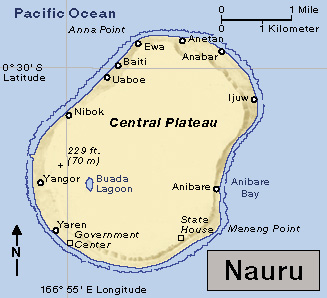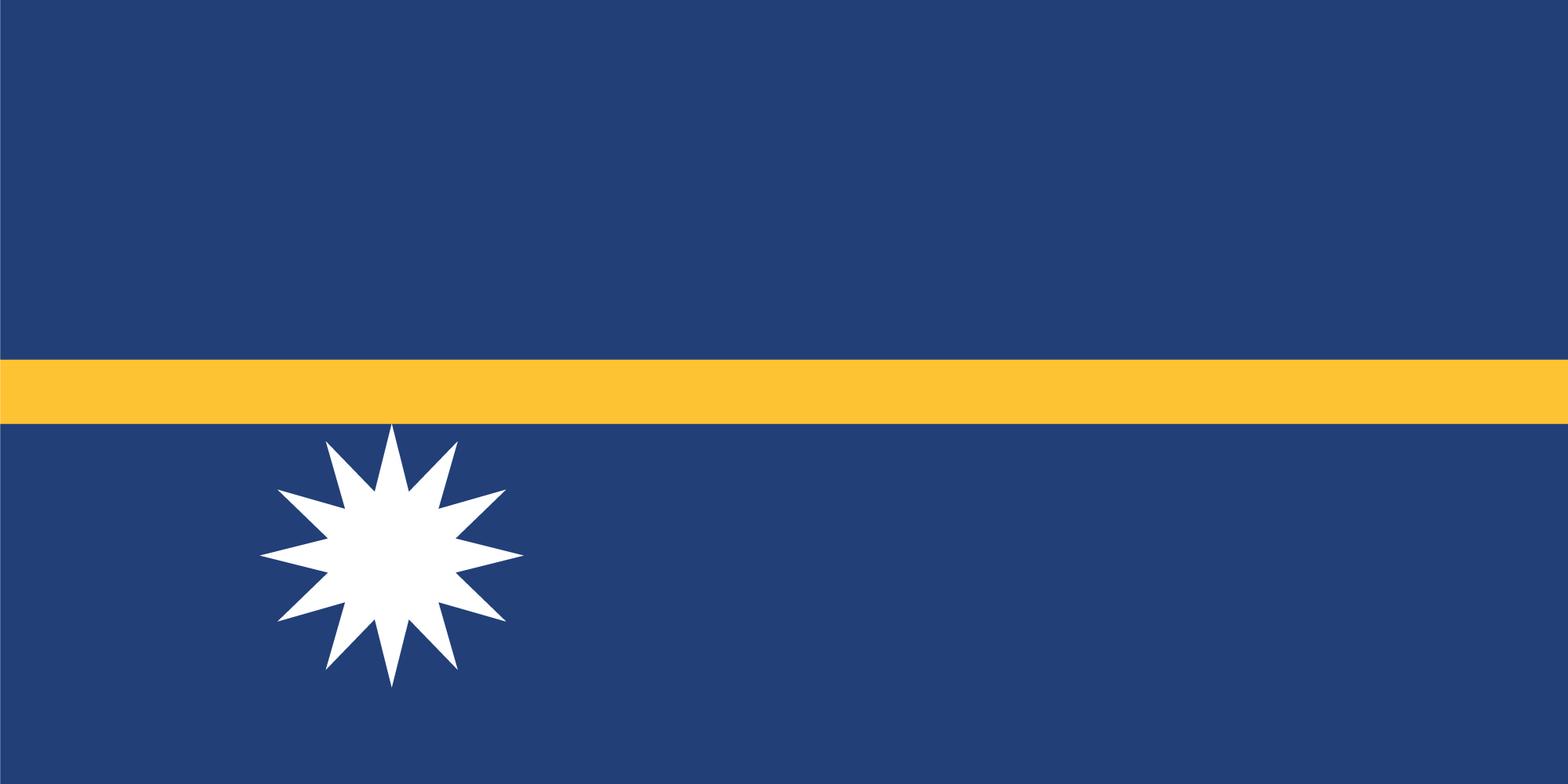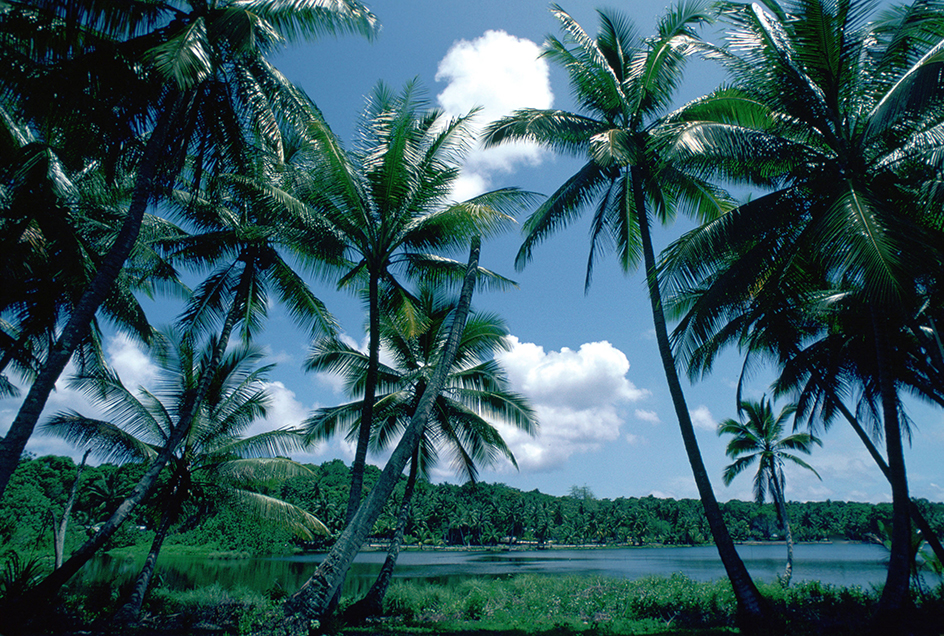Nauru << NAH roo >> is a small island country in the central Pacific Ocean. It is part of Micronesia, one of the three groups of the Pacific Islands. Nauru consists of a single island, which has an area of only 8 square miles (21 square kilometers). It is the third smallest country in the world. Only Vatican City and Monaco are smaller. For many years, the mining of phosphates (valuable chemical compounds used in making fertilizers) earned the majority of the Nauruan government’s revenue. However, phosphate reserves on the tiny island are now largely depleted.

Nauru has no capital city. The main government offices of the country are on the southwestern part of the island. The Australian dollar is Nauru’s basic unit of currency.
Government.
Nauru is a republic and a member of the Commonwealth of Nations. A 19-member Parliament makes the country’s laws. Parliament members are elected by the people to three-year terms. All Nauruans who are 20 years old or older are required to vote. The Parliament elects a president to a three-year term. The president selects a Cabinet. The president and the Cabinet carry out the executive functions of the government.

Land.
Nauru, an oval-shaped coral island, lies about 40 miles (65 kilometers) south of the equator. Most of the island is a plateau, 200 feet (61 meters) high, which contains deposits of phosphates. Near the center of the plateau is a lagoon surrounded by a small area of fertile land. Another belt of fertile land lies along the coast.

Most of the people live along the 12-mile (19-kilometer) coastline. In the past, the people raised their own food. Now, they import most of their food and other products they need. Nauru has a tropical climate that is cooled by trade winds. Temperatures range from 76 °F (24 °C) to 93 °F (34 °C). About 80 inches (200 centimeters) of rain falls yearly.
People.
About half of Nauru’s population of 12,000 are Nauruans—people of mixed Polynesian, Micronesian, and Melanesian ancestry. They are Christians. Most of them speak both the Nauruan language and English. The rest of Nauru’s people are from Kiribati, Tuvalu, China, and Australia. They come for limited periods of time to help mine the phosphates.
The government provides Nauruans with modern homes at low rents, and government hospitals and clinics give them free medical care. Nauruan children from the ages of 6 through 16 receive free education and must attend school. Some older Nauruan students attend the University of the South Pacific in Fiji, an island country to the south.
Economy.
For many years, Nauru’s economy has been dependent on phosphate mining. The government established a trust fund with revenue from phosphate sales. This trust fund was to help Nauru’s economy after its phosphate reserves were exhausted. However, the phosphate reserves are now largely depleted, and the trust fund is mostly spent. For these reasons, the island is nearly bankrupt and is heavily dependent on foreign aid. Nauru has little agricultural or industrial production and must import most of its food.
History.
Nauru was first settled by Polynesian and Micronesian seafarers several thousand years ago. Captain John Fearn, an English explorer, was the first European to visit Nauru. He came in 1798. In 1888, Germany took over the island and administered it until 1914 when Australia took control. After World War I (1914-1918), Australia began to administer the island under a League of Nations mandate held also by Britain, Australia, and New Zealand.
Japan seized Nauru during World War II (1939-1945). In 1945, Australian forces retook the island. In 1947, the United Nations (UN) provided for Australian control of the island under a trusteeship held also by Britain and New Zealand. In 1964, Nauru began to work for independence and control of the phosphate industry. Nauru became independent in 1968 after a UN-supervised plebiscite (popular vote). In 1970, the Nauruan government gained control of the phosphate industry. It used revenue from phosphate exports to build homes, schools, and hospitals, and Nauruans enjoyed a high standard of living through the 1980’s. Since then, diminishing phosphate reserves, unsuccessful investments by the government, and problems in Nauru’s banking industry have caused economic hardship for the country.
In 2001, the governments of Australia and Nauru forged an agreement under which Australia provided Nauru with financial assistance. In return, Australia was allowed to hold people seeking political asylum (shelter and protection) in a detention center on Nauru until their claims could be processed. Australia faced a growing number of people seeking asylum at the time. The detention center operated until 2008. The number of asylum seekers remained a problem for Australia, and the Nauru detention center was reopened in 2012. The last people were moved out of the center in 2019. But a few of them were still housed within the communities on Nauru. In June 2023, the last asylum seeker housed on Nauru left the island. In late 2023, however, the Australian government again began sending asylum seekers to Nauru for processing. See Australia, History of (Refugees).
